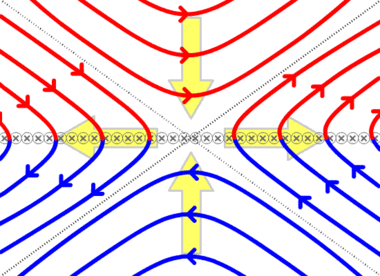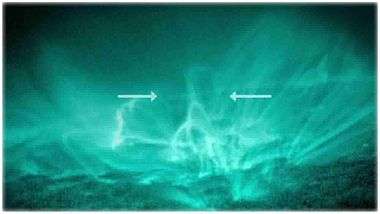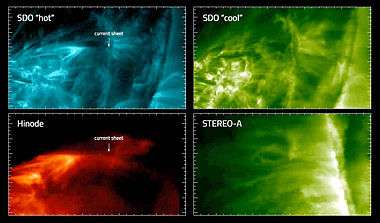Magnetic reconnection



Magnetic reconnection is a physical process in highly conducting plasmas in which the magnetic topology is rearranged and magnetic energy is converted to kinetic energy, thermal energy, and particle acceleration. Magnetic reconnection occurs on timescales intermediate between slow resistive diffusion of the magnetic field and fast Alfvénic timescales.
The qualitative description of the reconnection process is such that magnetic field lines from different magnetic domains (defined by the field line connectivity) are spliced to one another, changing their patterns of connectivity with respect to the sources. It is a violation of an approximate conservation law in plasma physics, called the Alfvén's Theorem, and can concentrate mechanical or magnetic energy in both space and time. Solar flares, the largest explosions in the Solar System, may involve the reconnection of large systems of magnetic flux on the Sun, releasing, in minutes, energy that has been stored in the magnetic field over a period of hours to days. Magnetic reconnection in Earth's magnetosphere is one of the mechanisms responsible for the aurora, and it is important to the science of controlled nuclear fusion because it is one mechanism preventing magnetic confinement of the fusion fuel.
In an electrically conductive plasma, magnetic field lines are grouped into 'domains'— bundles of field lines that connect from a particular place to another particular place, and that are topologically distinct from other field lines nearby. This topology is approximately preserved even when the magnetic field itself is strongly distorted by the presence of variable currents or motion of magnetic sources, because effects that might otherwise change the magnetic topology instead induce eddy currents in the plasma; the eddy currents have the effect of canceling out the topological change.
In two dimensions, the most common type of magnetic reconnection is separator reconnection, in which four separate magnetic domains exchange magnetic field lines. Domains in a magnetic plasma are separated by separatrix surfaces: curved surfaces in space that divide different bundles of flux. Field lines on one side of the separatrix all terminate at a particular magnetic pole, while field lines on the other side all terminate at a different pole of similar sign. Since each field line generally begins at a north magnetic pole and ends at a south magnetic pole, the most general way of dividing simple flux systems involves four domains separated by two separatrices: one separatrix surface divides the flux into two bundles, each of which shares a south pole, and the other separatrix surface divides the flux into two bundles, each of which shares a north pole. The intersection of the separatrices forms a separator, a single line that is at the boundary of the four separate domains. In separator reconnection, field lines enter the separator from two of the domains, and are spliced one to the other, exiting the separator in the other two domains (see the figure).
According to simple resistive magnetohydrodynamics (MHD) theory, reconnection happens because the plasma's electrical resistivity near the boundary layer opposes the currents necessary to sustain the change in the magnetic field. The need for such a current can be seen from one of Maxwell's equations,
The resistivity of the current layer allows magnetic flux from either side to diffuse through the current layer, cancelling out flux from the other side of the boundary. When this happens, the plasma is pulled out by magnetic tension along the direction of the magnetic field lines. The resulting drop in pressure pulls more plasma and magnetic flux into the central region, yielding a self-sustaining process.
A current problem in plasma physics is that observed reconnection happens much faster than predicted by MHD in high Lundquist number plasmas: solar flares, for example, proceed 13-14 orders of magnitude faster than a naive calculation would suggest, and several orders of magnitude faster than current theoretical models that include turbulence and kinetic effects. One possible mechanism to explain the discrepancy is that the electromagnetic turbulence in the boundary layer is sufficiently strong to scatter electrons, raising the plasma's local resistivity. This would allow the magnetic flux to diffuse faster.
Theoretical descriptions of magnetic reconnection
The Sweet-Parker Model
At a conference in 1956, Peter Sweet pointed out that by pushing two plasmas with oppositely directed magnetic fields together, resistive diffusion is able to occur on a length scale much shorter than a typical equilibrium length scale.[2] Eugene Parker was in attendance at this conference and developed scaling relations for this model during his return travel.[3]
The Sweet-Parker model describes time-independent magnetic reconnection in the resistive MHD framework when the reconnecting magnetic fields are antiparallel (oppositely directed) and effects related to viscosity and compressibility are unimportant. The ideal Ohm's law then yields the relation
where is the out-of-plane electric field, is the characteristic inflow velocity, and is the characteristic upstream magnetic field strength. By neglecting displacement current, the low-frequency Ampere's law, , gives the relation
where is the current sheet half-thickness. This relation uses that the magnetic field reverses over a distance of . By matching the ideal electric field outside of the layer with the resistive electric field inside the layer (using Ohm's law), we find that
where is the magnetic diffusivity. When the inflow density is comparable to the outflow density, conservation of mass yields the relationship
where is the half-length of the current sheet and is the outflow velocity. The left and right hand sides of the above relation represent the mass flux into the layer and out of the layer, respectively. Equating the upstream magnetic pressure with the downstream dynamic pressure gives
where is the mass density of the plasma. Solving for the outflow velocity then gives
where is the Alfvén velocity. With the above relations, the dimensionless reconnection rate can then be written in two forms, the first in terms of using the result earlier derived from Ohm's law, the second in terms of from the conservation of mass as
Since the dimensionless Lundquist number is given by
the two different expressions of are multiplied by each other and then square-rooted, giving a simple relation between the reconnection rate and the Lundquist number
Sweet-Parker reconnection allows for reconnection rates much faster than global diffusion, but is not able to explain the fast reconnection rates observed in solar flares, the Earth's magnetosphere, and laboratory plasmas. Additionally, Sweet-Parker reconnection neglects three-dimensional effects, collisionless physics, time-dependent effects, viscosity, compressibility, and downstream pressure. Numerical simulations of two-dimensional magnetic reconnection typically show agreement with this model.[4] Results from the Magnetic Reconnection Experiment (MRX) of collisional reconnection show agreement with a generalized Sweet-Parker model which incorporates compressibility, downstream pressure, and anomalous resistivity.[5]
The Petschek Model
One of the reasons why Sweet-Parker reconnection is slow is that the aspect ratio of the reconnection layer is very large in high Lundquist number plasmas. The inflow velocity, and thus the reconnection rate, must then be very small. In 1964, Harry Petschek proposed a mechanism where the inflow and outflow regions are separated by stationary slow mode shocks.[6] The aspect ratio of the diffusion region is then of order unity and the maximum reconnection rate becomes
This expression allows fast reconnection almost independent of the Lundquist number.
Simulations of resistive MHD reconnection with uniform resistivity showed the development of elongated current sheets in agreement with the Sweet-Parker model rather than the Petschek model. When a localized anomalously large resistivity is used, however, Petschek reconnection can be realized in resistive MHD simulations. Because the use of an anomalous resistivity is only appropriate when the particle mean free path is large compared to the reconnection layer, it is likely that other collisionless effects become important before Petschek reconnection can be realized.
Collisionless reconnection
On length scales shorter than the ion inertial length (where is the ion plasma frequency), ions decouple from electrons and the magnetic field becomes frozen into the electron fluid rather than the bulk plasma. On these scales the Hall effect becomes important. Two-fluid simulations show the formation of an X-point geometry rather than the double Y-point geometry characteristic of resistive reconnection. The electrons are then accelerated to very high speeds by Whistler waves. Because the ions can move through a wider "bottleneck" near the current layer and because the electrons are moving much faster in Hall MHD than in standard MHD, reconnection may proceed more quickly. Two-fluid/collisionless reconnection is particularly important in the Earth's magnetosphere.
Anomalous Resistivity and Bohm Diffusion
In the Sweet-Parker model, the common assumption is that the magnetic diffusivity is constant. This can be estimated using the equation of motion for an electron with mass and electric charge :
where is the collision frequency. Since in the steady state, , then the above equation along with the definition of electric current, , where is the electron number density, yields
Nevertheless, if the drift velocity of electrons exceeds the thermal velocity of plasma, a steady state cannot be achieved and magnetic diffusivity should be much larger than what is given in the above. This is called anomalous resistivity, , which can enhance the reconnection rate in the Sweet-Parker model by a factor of .
Another proposed mechanism is known as the Bohm diffusion across the magnetic field. This replaces the Ohmic resistivity with , however, its effect, similar to the anomalous resistivity, is still too small compared with the observations.[7]
Stochastic Reconnection
Lazarian and Vishniac (1999) considered the magnetic reconnection in the presence of a random component of magnetic field in a totally ionized and inviscid plasma assuming that the resistive effects could be described with an Ohmic resistivity.[8] For the turbulent flow in the reconnection region a model for magnetohydrodynamic turbulence should be used such as the model developed by Goldreich and Sridhar in 1995.[9] One can imagine that within small scales of the turbulent flow, the Sweet-Parker model is applicable. Lazarian and Vishniac showed that, in general, this cannot affect the final result. In fact, their model is independent of small scale physics which determines the local reconnection rate. According to this model, for a current sheet of the length , the upper limit for reconnection velocity is given by
where . Here , and are turbulence injection length scale and velocity respectively and is the Alfvén velocity. This model has been successfully tested by numerical simulations.[10][11]
Observations of magnetic reconnection in nature and the laboratory
The Solar Atmosphere
Magnetic reconnection occurs during solar flares, coronal mass ejections, and many other events in the solar atmosphere. The observational evidence for solar flares includes observations of inflows/outflows, downflowing loops, and changes in the magnetic topology. In the past, observations of the solar atmosphere were done using remote imaging; consequently, the magnetic fields were inferred or extrapolated rather than observed directly. However, the first direct observations of solar magnetic reconnection were gathered in 2012 (and released in 2013) by the High Resolution Coronal Imager.[12]
The Earth's magnetosphere
New measurements from the Cluster mission for the first time now can determine unambiguously the scale sizes of magnetic reconnection in the Earth's magnetosphere, both on the dayside magnetopause and in the magnetotail. Cluster is a four-spacecraft mission, with the four spacecraft in a tetrahedron arrangement, to separate spatial from temporal changes as the suite flies through space. Cluster has now also unambiguously discovered 'reverse reconnection' near the polar cusps. 'Dayside reconnection' allows interconnection of the Earth's magnetic field with that of the Sun (the Interplanetary Magnetic Field), allowing particle and energy entry into the Earth's vicinity. Tail reconnection allows release of energy stored in the Earth's magnetic tail, injecting particles deep into the magnetosphere, causing auroral substorms. 'Reverse reconnection' is reconnection of Earth's tail magnetic fields with northward Interplanetary Magnetic Fields, causing sunward convection in the Earth's ionosphere. The Magnetospheric Multiscale Mission, launched on 13 March 2015, is improving on Cluster results by having a tighter constellation of spacecraft, allowing finer spatial measurements and finer time detail. In this way the behavior of the electrical currents in the electron diffusion region will be better understood.
On 26 February 2008, THEMIS probes were able to determine, for the first time, the triggering event for the onset of magnetospheric substorms.[13] Two of the five probes, positioned approximately one third the distance to the Moon, measured events suggesting a magnetic reconnection event 96 seconds prior to Auroral intensification.[14] Dr. Vassilis Angelopoulos of the University of California, Los Angeles, who is the principal investigator for the THEMIS mission, claimed, "Our data show clearly and for the first time that magnetic reconnection is the trigger.".[15]
Laboratory Plasma Experiments
The process of magnetic reconnection has been studied in detail by dedicated laboratory experiments, such as the Magnetic Reconnection Experiment (MRX) at Princeton Plasma Physics Laboratory (PPPL). Experiments such as these have confirmed many aspects of magnetic reconnection, including the Sweet-Parker model in regimes where this model is applicable.[16]
The confinement of plasma in devices such as tokamaks, spherical tokamaks, and reversed field pinches requires the presence of closed magnetic flux surfaces. By changing the magnetic topology, magnetic reconnection degrades confinement by disrupting these closed flux surfaces, allowing the hot central plasma to mix with cooler plasma closer to the wall.
See also
References
- Eric Priest, Terry Forbes, Magnetic Reconnection, Cambridge University Press 2000, ISBN 0-521-48179-1, contents and sample chapter online
- Discoveries about magnetic reconnection in space could unlock fusion power, Space.com, 6 February 2008
- Nasa MMS-SMART mission, The Magnetospheric Multiscale (MMS) mission, Solving Magnetospheric Acceleration, Reconnection, and Turbulence. Due for launch in 2014.
- Cluster spacecraft science results
- ↑ Zhu et al., 2016, ApJ, 821, L29, http://iopscience.iop.org/article/10.3847/2041-8205/821/2/L29
- ↑ Sweet, P. A., The Neutral Point Theory of Solar Flares, in IAU Symposium 6, Electromagnetic Phenomena in Cosmical Physics, ed. B. Lehnert (Dordrecht: Kluwer), 123, 1958
- ↑ Parker, E. N., Sweet's Mechanism for Merging Magnetic Fields in Conducting Fluids, J. Geophys. Res., 62, 509, 1957
- ↑ Biskamp, D., Magnetic reconnection via current sheets, Physics of Fluids, 29, 1520, 1986
- ↑ Ji, H., M. Yamada, S. Hsu, R. Kulsrud, T. Carter, & S. Zaharia, Magnetic reconnection with Sweet-Parker characteristics in two-dimensional laboratory plasmas, Physics of Plasmas, 6, 1743, 1999
- ↑ Petschek, H. E., Magnetic Field Annihilation, in The Physics of Solar Flares, Proceedings of the AAS-NASA Symposium held 28–30 October 1963 at the Goddard Space Flight Center, Greenbelt, MD, p. 425, 1964
- ↑ Parker, E. G. (1979). Cosmical Magnetic Fields. Oxford: Oxford University Press.
- ↑ Lazarian, Alex; Vishniac, Ethan (1999). "Reconnection in a Weakly Stochastic Field". The Astrophysical Journal. 517: 700–718. arXiv:astro-ph/9811037
 . Bibcode:1999ApJ...517..700L. doi:10.1086/307233.
. Bibcode:1999ApJ...517..700L. doi:10.1086/307233. - ↑ Goldreich, P.; Sridhar, S. (1995). "Toward a theory of interstellar turbulence. 2: Strong alfvenic turbulence". The Astrophysical Journal. 438: 763. Bibcode:1995ApJ...438..763G. doi:10.1086/175121.
- ↑ Kowal, G.; Lazarian, A.; Vishniac, E.; Otmianowska-Mazur, K. (2009). "NUMERICAL TESTS OF FAST RECONNECTION IN WEAKLY STOCHASTIC MAGNETIC FIELDS". The Astrophysical Journal. 700: 63. arXiv:0903.2052
 . Bibcode:2009ApJ...700...63K. doi:10.1088/0004-637X/700/1/63.
. Bibcode:2009ApJ...700...63K. doi:10.1088/0004-637X/700/1/63. - ↑ Kowal, G; Lazarian, A.; Vishniac, E.; Otmianowska-Mazur, K. (2012). "Reconnection studies under different types of turbulence driving". Nonlinear Processes in Geophysics. 19: 297–314. arXiv:1203.2971
 . Bibcode:2012NPGeo..19..297K. doi:10.5194/npg-19-297-2012.
. Bibcode:2012NPGeo..19..297K. doi:10.5194/npg-19-297-2012. - ↑ "High-Resolution Coronal Imager Photographs the Sun in UV Light at 19.3nm Wavelength". AZonano.com. January 24, 2013. Retrieved February 9, 2013.
- ↑ "THEMIS Satellites Discover What Triggers Eruptions of the Northern Lights". NASA.
- ↑ Vassilis Angelopoulos. "Tail Reconnection Triggering Substorm Onset". sciencemag.org.
- ↑ "Secret of Colorful Auroras Revealed". Space.com.
- ↑ Ji, H.; et al. (May 1999). "Magnetic reconnection with Sweet-Parker characteristics in two-dimensional laboratory plasmas". Physics of Plasmas. 6 (5): 1743. Bibcode:1999PhPl....6.1743J. doi:10.1063/1.873432.